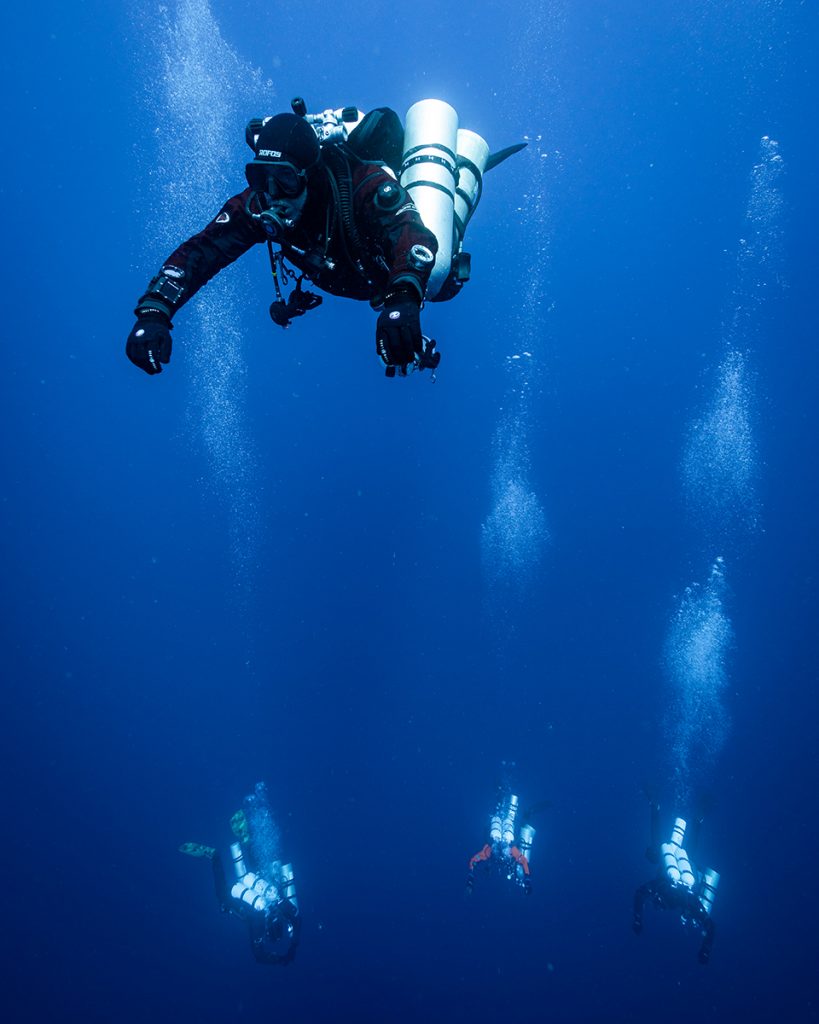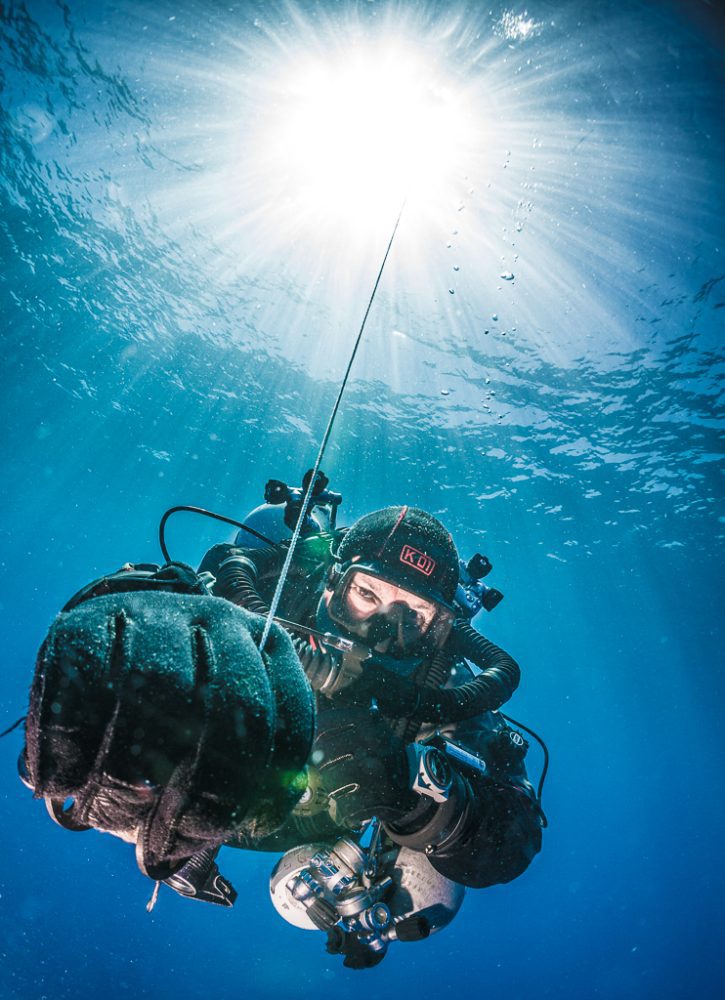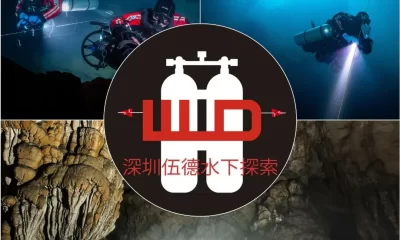Education
Rules of Thumb: The Mysteries of Ratio Deco Revealed
Is it a secret algorithm developed by the WKPP to get you out of the water faster sans DCI, or an unsubstantiated decompression speculation promoted by Kool-Aid swilling quacks and charlatans? British tech instructor/instructor evaluator Rich Walker divulges the arcane mysteries behind GUE’s ratio decompression protocols in this first of a two part series.

By Richard Walker
Header photo: Diver image by Derk Remmers.
Some ideas take on an undeserved aura of mystery. When ideas are inadequately understood (or explained), people have a tendency to either regard them as some sort of undeniable truth, or reject them as unmitigated nonsense.
Ratio decompression (RD) is one such idea. I know people who believe that RD is some kind of magic formula that will protect them from decompression sickness, get them back to the surface faster than anyone else, and leave them feeling more refreshed than they were before the dive. I also know people who consider it to be reckless, unsubstantiated foolhardiness, promoted by quacks and charlatans with less grip on reality than the Flat Earth Society.
The reality, of course, lies somewhere in the middle.
In this article, I want to try and explain the ideas, history, and motivation behind using a tool like Ratio Decompression.
RD aside, there are two ways you can manage a decompression dive. The first is to carry a computer set up to reflect the gas you’re breathing and the conservatism factors you believe are appropriate. You can then jump in, make the dive, and follow the instructions given by the machine. The second method is to plan a series of profiles—using either tables or planning software—and write down a handful of them to cover any realistic variation in depth and bottom time that might happen during the course of the dive.
You could, of course, do both and carry a range of plans in Wet Notes and then compare these with the instructions from a computer; but, that does seem rather complex. And you are always left with solving the conundrum posed by Confucius in 500 BC: “A man with two watches never really knows the time.”
But what if this could all be simplified? Most people that dived air back in the day would know the simple rule that their no-stop time at 100 ft/30 m was about 20 minutes. The No Decompression Limit (NDL) at 70 ft/21 m was around 50 minutes. It doesn’t take a Nobel Prize winner to figure that the NDL at 80 ft/24 m would be around half way between those two numbers, or 40 minutes. In the imperial system, this was called the 120 Rule, because NDL + depth = 120. This rule of thumb can’t be directly converted to the metric system unless you’re a math whiz, but then that would defeat the purpose of keeping it simple. A metric version does actually exist, but the way you calculate it is a little different. Amazingly, it works just as well.
The logical follow-up question is, “What happens if you stray beyond the no-stop time? Do you have to go back to tables, or buy a $1,000 computer?” Amazingly, you can come up with a pretty simple rule for this eventuality as well. Let’s look at a decompression table for air. The 120 Rule is highlighted in green, showing the NDL. Some tables show a few minutes of decompression, but nothing longer than a good old safety stop, right?

Rules of Thumb for Air
Now look at the decompression times, which are to the right of the green areas and are highlighted in red. For these dives, all of the decompression comes in at 6 m/20 ft.
If you close one eye, and look sideways at the table you should start to see a pattern emerging for the required amount of decompression. Your decompression obligation relates to the number of minutes of bottom time you do longer than the no-stop time. It is approximately one minute of decompression for every minute past the no-stop time. The table below shows the idea.
Here, the decompression predicted by software is labeled “real deco,” while the result of the 120 Rule is labeled “ratio.” The “error” label indicates the discrepancy between “real” and “ratio.” For the vast majority of these dives, the 120 Rule calculation is within one minute of the true decompression, if not more conservative. There are a few results where the decompression is insufficient (more than one minute of error) and these are highlighted in red.
So, the first thing to note is that this is a pretty useful concept. And the second, perhaps the most important, is that it has limits that you need to define or understand before using it.
Those dives where the error in RD is more than one minute only occur on dives that build up more than 30 minutes of decompression, so this becomes our defining limit for the RD tool. To clarify, based upon the table above, the following is true: For dives shallower than 30 m/100 ft, the required decompression time equals the bottom time minus the NDL at that particular depth, as long as the decompression time does not exceed 30 minutes.
How About For Voodoo Gas?
This approach has been developed assuming that the diver is breathing air. Now, for those of you still diving air, please try and catch up with the rest of the world! [Ed.note: Compressed air is for tires!] For these 30 m/100 ft dives, nitrox 32 is a much better choice of gas. Your NDL is longer, meaning you’ve less need of a RD tool or a $1,000 computer to complete an equivalent dive. But, should you want to go past the NDL on nitrox 32, then the exact same rule can be used (believe it or not). The diver’s required decompression at 6 m/20 ft is equal to bottom time minus the NDL at that depth. Or in other words, one minute of decompression for every minute past the NDL.
Don’t believe me? Let’s repeat the process we’ve just done, but for nitrox 32. First we need a simple way of calculating the NDL. It turns out that a 130 Rule exists for nitrox 32. Your NDL is simply 130 minus your depth in feet. These are shown in green in the table below, just like before, and then the decompression stops needed at bottom times out to 75 minutes.
You can see that the 130 Rule works pretty well and—just like its air diving brother—is conservative in shallower water. So what about the decompression? Squinting at the table again, you’ll see that for every minute past the NDL, you need about 30 seconds of decompression. So a 40-minute dive at 30 m/100 ft would need five minutes of decompression, compared to the five minutes required by the table. There’s another advantage of nitrox 32 over air—comparable dives require less decompression. But that’s now two rules, and I like simple things. If you just stick to “One minute past the NDL gives you one minute of decompression,” even I can work that out. If you run the comparison table again you can see how the rule performs.
You can see pretty quickly that this rule doesn’t become aggressive at all. There are no “red zones” on this table, which is partly due to the conservative interpretation of the calculation (and a little conservatism is no bad thing). Our RD rule for calculating decompression on nitrox 32 dives is then very similar to the one for air. The required decompression time at 6 m/100 ft is equal to bottom time minus the NDL at that depth. Or, in other words, one minute of decompression for every minute past the NDL.
The Virtues of Oxygen
I don’t know about you, but for me, most of the time decompression is a chore, but it’s also painful when you get it wrong. It doesn’t pay to cut corners despite the allure of a faster decompression. But there is a way to reduce your decompression time, and that’s to use a decompression gas. For dives like this, all of the stop time is at 6 m/20 ft, so oxygen is an ideal choice if you’re qualified to use it.

I’m not going to go through the whole process again – at this level of diving, you should prove things to yourself rather than trust some clown on the internet. In short, you can use the same rule as before, but if you switch to oxygen at 6 m/20 ft, observing all proper switch procedures, gas handling protocols, and other things your mother should have taught you, then you can reduce the decompression time by half.
So, if you’d planned a dive needing 30 minutes of decompression on nitrox 32, using oxygen at 6 m/20 ft would reduce that time to 15 minutes. This is, again, a very conservative implementation, but that’s a good thing in my book. But like I said, don’t take my word for it: get yourself a copy of GUE’s Deco Planner and prove it to yourself.
In the next installment of this article, I’m going to expand the discussion to deeper dives—which will draw more on the ideas we’ve developed about ratio decompression here—and use them to plan dives in the 30-50 m/100-170 ft range.
See: Rules of Thumb 2: Further Mysteries of Ratio Deco Revealed . Are you able to calculate your decompression for a 40-50m/130-165 ft dive using only your gas mix, average depth and bottom time? Here British techmeister Rich Walker further divulges the enigmatic mysteries behind GUE’s ratio decompression protocols in this part two of the series.
Dive Deeper:
InDepth: Standard Gases: The Simplicity of Everyone Singing the Same Song by Richard Walker
InDepth: Maintaining Unit Cohesion by Richard Walker
Wikipedia: Ratio Decompression

Rich Walker learned to dive in 1991 in the English Channel and soon developed a love for wreck diving. The UK coastline has tens of thousands of wrecks to explore, from shallow to deep technical dives. He became aware of GUE in the late 1990s as his diving progressed more into the technical realm, and he eventually took cave training with GUE in 2003. His path was then set, and he began teaching for GUE in 2004.
He is an active project diver, and is currently involved with:
Mars project, Sweden; Cave exploration team in Izvor Licanke, Croatia.; Ghost Fishing UK, Chairman and founder. He is also a full time technical instructor and instructor evaluator with GUE, delivering these services via his company, Wreck and Cave Ltd. He sits on GUE’s Board of Advisors and serves several other industry organizations.






















































